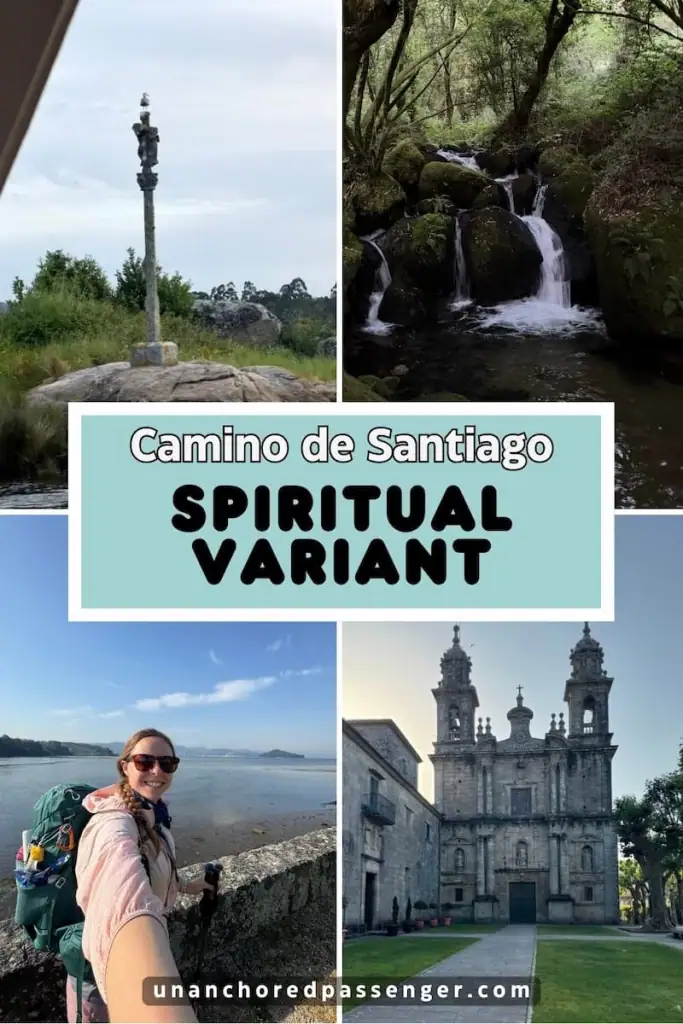Camino Spiritual Variant Details and Stages for 2025
Planning your Camino Portugués and wondering whether to take the Camino Spiritual Variant or stick to the main Central route? Is the Spiritual Variant worth it? How much longer will it take?
Spoiler alert: I think it’s absolutely worth it. I walked both the Central route and the Spiritual Variant to Santiago de Compostela in 2025, and I’m here to help you decide if the Spiritual Variant is right for you.
In this guide to the Camino Spiritual Variant, I’ll cover the route’s origins, walking stages, where to stay, and why it was one of my favorite stretches of the Portuguese Way. Everything here is based on my personal experience, so you’ll walk in knowing what to expect.
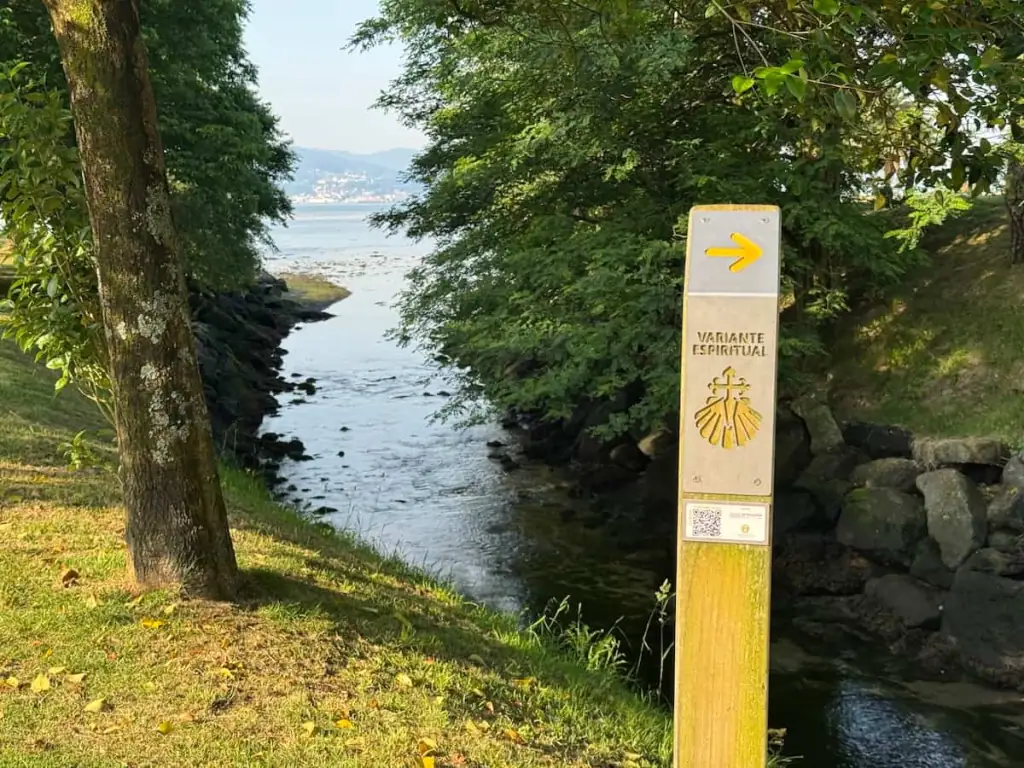
What is the Spiritual Variant?
The Spiritual Variant, also known as the Variante Espiritual in Spanish, is an alternate route along the Camino Portugués that pilgrims can take for a a portion of the last 100 km. It includes a boat ride that follows the same route that legend says the boat took to bring the remains of Saint James the Greater back into Galicia.
History of the Camino Portugués Spiritual Variant
Even though many people comparing the Francés to the Portugués might think the Francés is more historic, the Portuguese is hugely important historically, primarily because of the Spiritual Variant.
In fact, the Spiritual Variant has arguably the most historically important stretch along all of the Caminos since it follows the alleged path of the boat that started it all.
It is believed that Saint James the Greater, a disciple of Jesus, had been preaching in parts of Gallaecia (now Galicia) and what was then called Hispania (now modern day Roman Spain and Portugal). He later returned to Jerusalem where he was beheaded by order of King Herod Agrippa between 42 and 44 AD.
Legend says that after the death of Saint James, his disciples brought his body back to Galicia on a stone boat. They supposedly landed at Iria Flavia where modern day Padrón now sits.

Given this history, if your reason for hiking is primarily religious, then you'll definitely want to do the Spiritual Variant if you can.
I learned all about this history in the Museum of the Pilgrimage and Santiago in Santiago de Compostela and highly recommend it if you're looking for something to do in the city.
While its roots are historic, the Spiritual Variant did not become popular among pilgrims until recent years. According to one of the boat companies for the route, people started to build boats to travel that portion of the route in 1965. Later in the early 2000s, the full Spiritual Variant as we know it today was born.
Camino Spiritual Variant Map | Where is the Variante Espiritual?
The Variante Espiritual starts just north of Pontevedra, Spain. This means that you could walk the Spiritual Variant no matter whether you plan to hike the Central or Coastal route (or a mix of the two) beforehand.
The start of the route cuts westward, reaching the coastline before turning north again. From Vilanova de Arousa, pilgrims experience the highlight of this route: the boat ride that travels 17.4 miles (28 km) along the Ría de Arousa river up the Río Ulla river.
The boat drops pilgrims off in Pontecesures, just south of Padrón. There they rejoin the Camino Portugués Central route for the final 16.9 miles (27.2 km) to Santiago de Compostela.
In the map above, you can see my exact walking path. Note that I paused my GPS watch during the boat ride, so that line is a bit off, but you can still get an idea of what that journey is like.
Want to save a link of this map for later so you can access it on your own Google Maps? Fill in your name and email here:
We respect your privacy. Unsubscribe at anytime. See the Privacy Policy for more information.
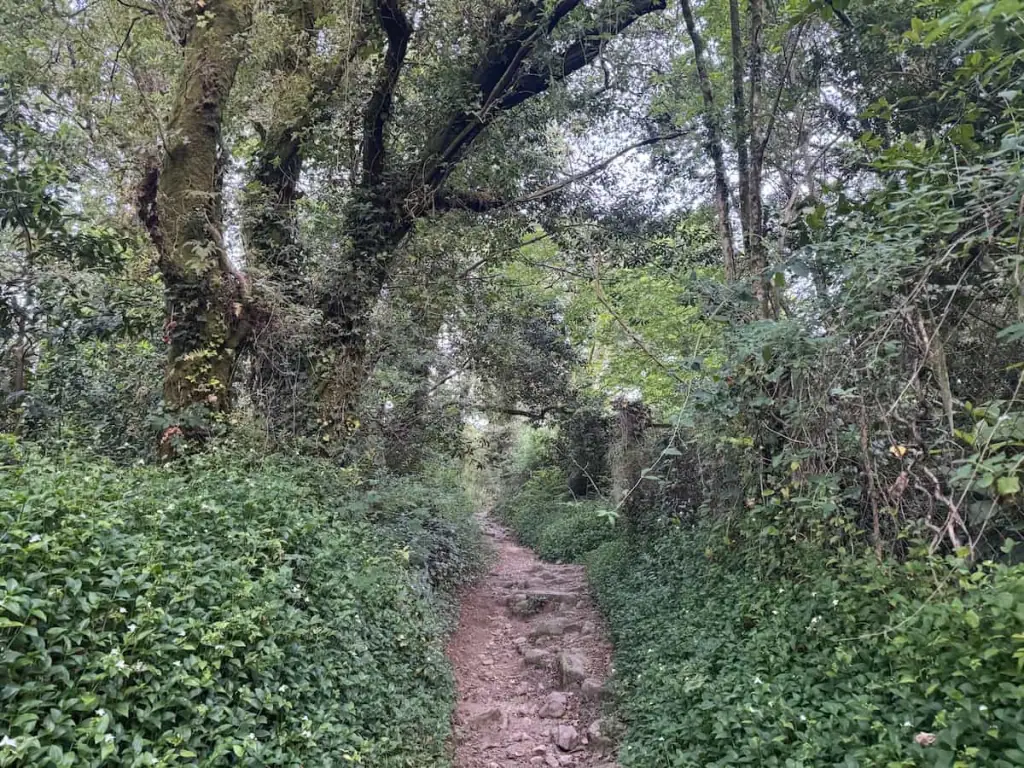
How Does the Spiritual Variant Compare to Staying on the Central Route of the Camino Portugués?
I really enjoyed the Spiritual Variant because of the historical importance to the Camino, fewer crowds, and the scenery.
While there are no official statistics tracking how many pilgrims walk the Spiritual Variant vs. continuing on the Central route, we know that over 170,000 pilgrims completed the Portuguese Way last year and the majority of them stayed on the Central route instead of taking the Spiritual Variant.
When it comes to scenery, the views along the Spiritual Variant reminded me of my favorite parts of the Camino Portugués Central route and the Coastal route. It could be a good choice for you if you're finding it hard to pick between the two routes.
Note that since the Variante Espiritual is less traveled, there aren't quite as many albergues to sleep in and places to stop along the way. If you don't book ahead, you may need to be a little more flexible with your plans.
I personally didn't book ahead at all on the Spiritual Variant, but I did feel slightly rushed trying to get to the albergues when they opened each day.
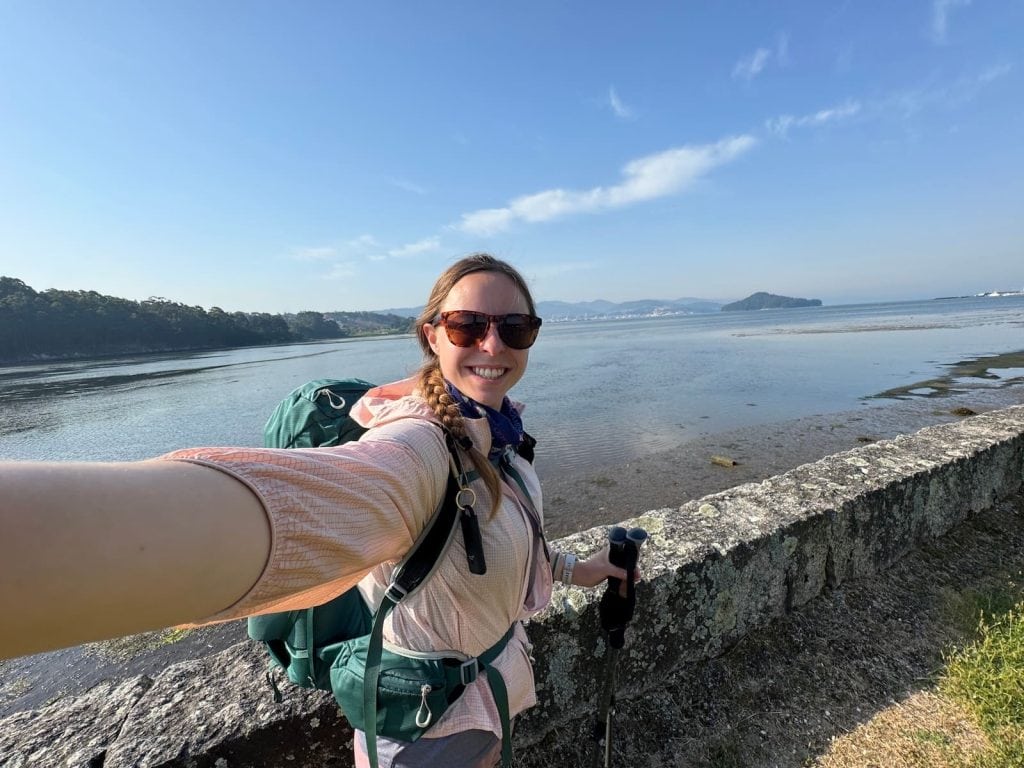
Here's a table providing a quick overview of how these two routes differ between Pontevedra and Santiago de Compostela:
Route Comparison from Pontevedra to Santiago de Compostela
| Spiritual Variant | Central Route | |
| Walking Distance | 44.4 miles (71.4 km) (if you take the boat) | 39.3 miles (63.3 km) |
| Average Days Needed | 3-4 | 3 |
| Crowds | Very quiet | Very crowded |
| Scenery | Mix of ocean views, forests, and small villages | Mix of forests, small villages, and towns |
| Infrastructure | Fewer places to stay and stop for food along the way | More places to stay and stop for food along the way |
| Mode of Transport | Walking and boat | Walking only |
Connect with Other Women Hiking the Camino
Join my free Facebook group! We're building up a community of women who have hiked or are planning to hike the Camino there. You can also get personalized support from me!
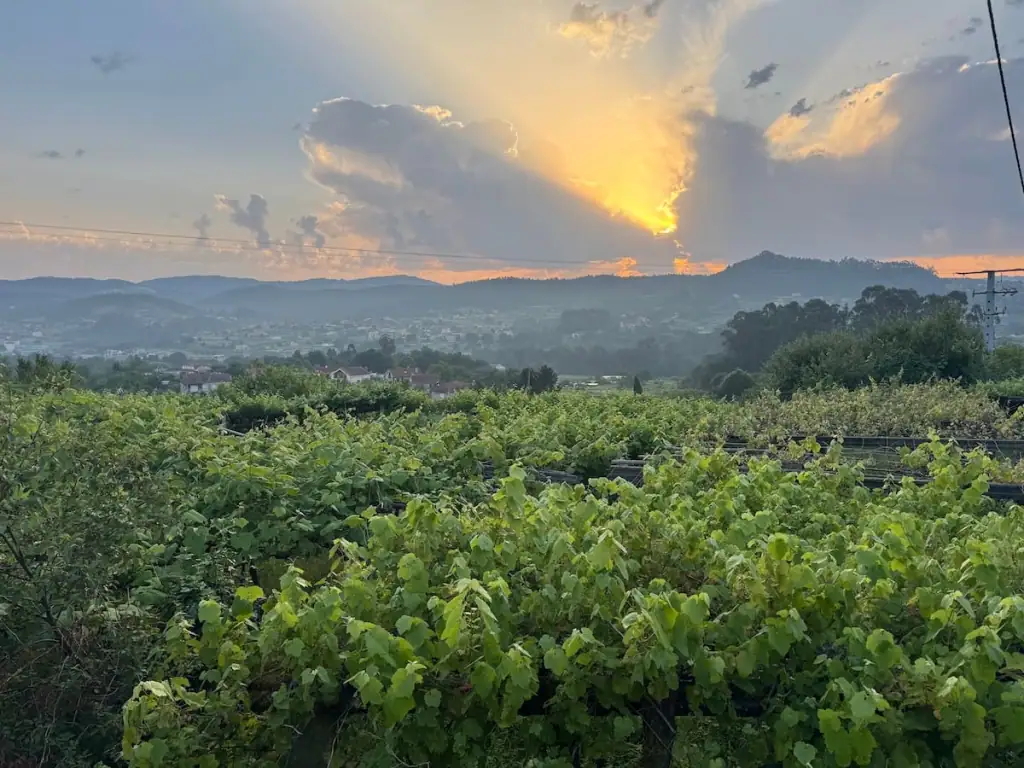
Camino Spiritual Variant Stages in 3-4 Days
I spent four days walking from the city of Pontevedra to Santiago de Compostela along the Spiritual Variant, one more day than I spent hiking the Central route.
Some people do it in three days, which I'll get into below, but it makes for a long last day, which is partly why I decided to do it in four. If you have the time, you may even want to do it in five days because there are so many lovely stops along the way.
Now let's dive into the Camino Spiritual Variant stages.
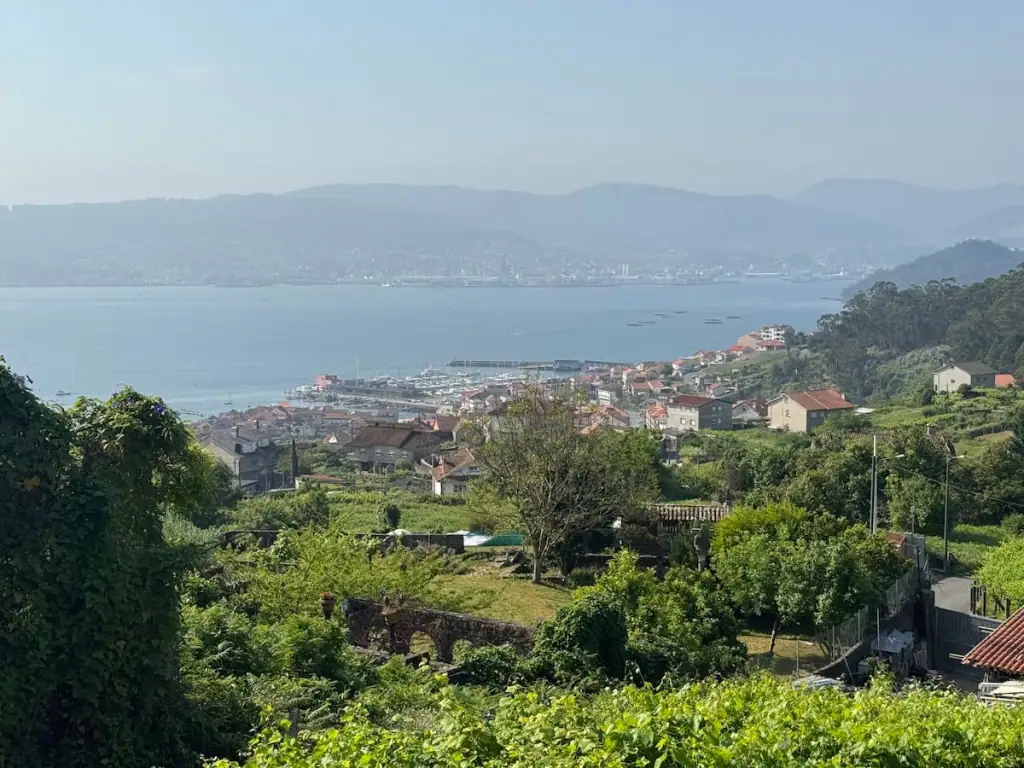
Stage 1: Pontevedra to Armenteira
Official Distance: 12.7 miles (20.5 km)
Elevation Gain: 2,110.2 ft (643.2 m)
Elevation Loss: 1,282.1 ft (390.8 m)
As you leave Pontevedra, you'll find yourself on a straight packed gravel path for a little bit. At the end of that path lies the split where you turn right at a paved road for the Camino Portugués Central route or turn left for the Spiritual Variant.
You might see many other pilgrims on your way out of Pontevedra, but once you take the turn left for the Spiritual Variant, you'll likely see few people around you. It's almost shocking at first.
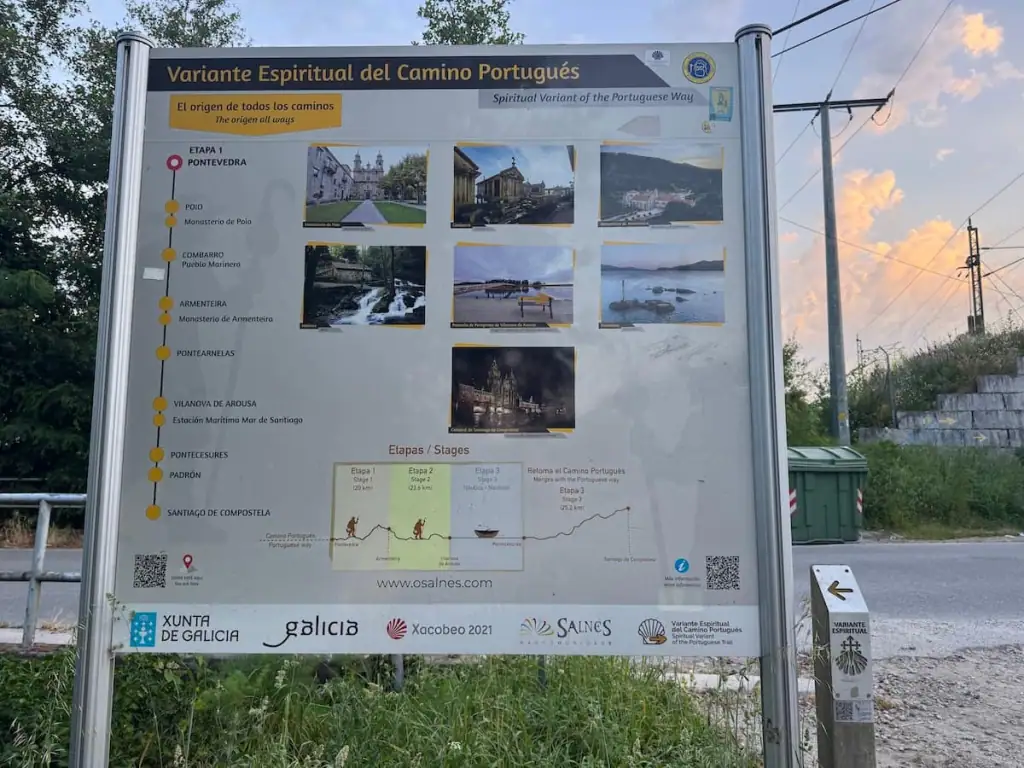
I remember walking out of Pontevedra seeing dozens of people in front of me. After I turned onto the Spiritual Variant, I didn't see anyone else until I stopped for breakfast.
The scenery on this hike is lovely. You spend much of the time walking through the woods and a little bit of time along the Ría de Pontevedra river not far from where it connects with the ocean.
There are some intense uphills on this hike, but you get some spectacular views along the way. I was definitely glad I packed my trekking poles!
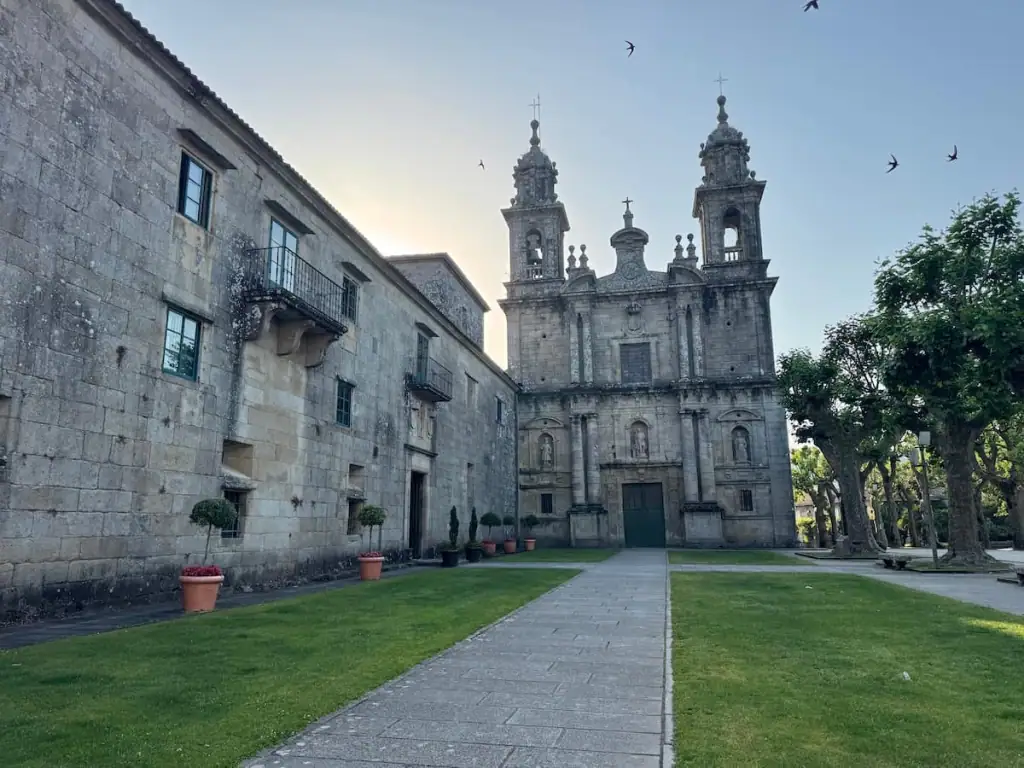
Stops Along the Way*
- Cabaleiro (3.4 miles/5.5 km from previous stop)–Hotel Campagniola here has a lovely cafe with a covered outdoor terrace.
- Fragmoreira (0.6 miles/1.0 km from previous stop)
- Poio (1.2 miles/1.9 km from previous stop)–The monastery, Mosteiro de San Xoán de Poio, is a highlight to see along the Spiritual Variant. It's open 10 a.m. to 1 p.m. and 4:30 to 7:30 p.m. every day except on Sundays and holidays, it's closed in the mornings. Bar Castro is a good spot to stop for breakfast.
- Combarro (1.9 miles/3.0 km from previous stop)–This is such a charming historic fishing village that you must spend an extra 15 minutes popping off the Camino to explore. If you have a day to spare, I highly recommend spending the night here. For a place to stay, check out Albergue Hostel Nuestra Señora del Camino or Hotel Combarro.
- Miradoiro do Loureiro (2.2 miles/3.6 km from previous stop)–Leaving Combarro, you climb up some steep hills for almost 1,000 feet (304 m) in elevation gain to this viewpoint. Even after the lookout point, you'll find some uphill stretches–reaching almost 1,400 feet in elevation gain (427 m) until you're almost in Armenteira.
After the Miradoiro do Loureiro, it's 3.5 miles/5.6 km to Armenteira.
*Note that I've listed all the places you'll pass through according to the Wise Pilgrim app (Apple | Android) in this article. Not all of these towns will necessarily have a place where you can stop to get food or spend the night.
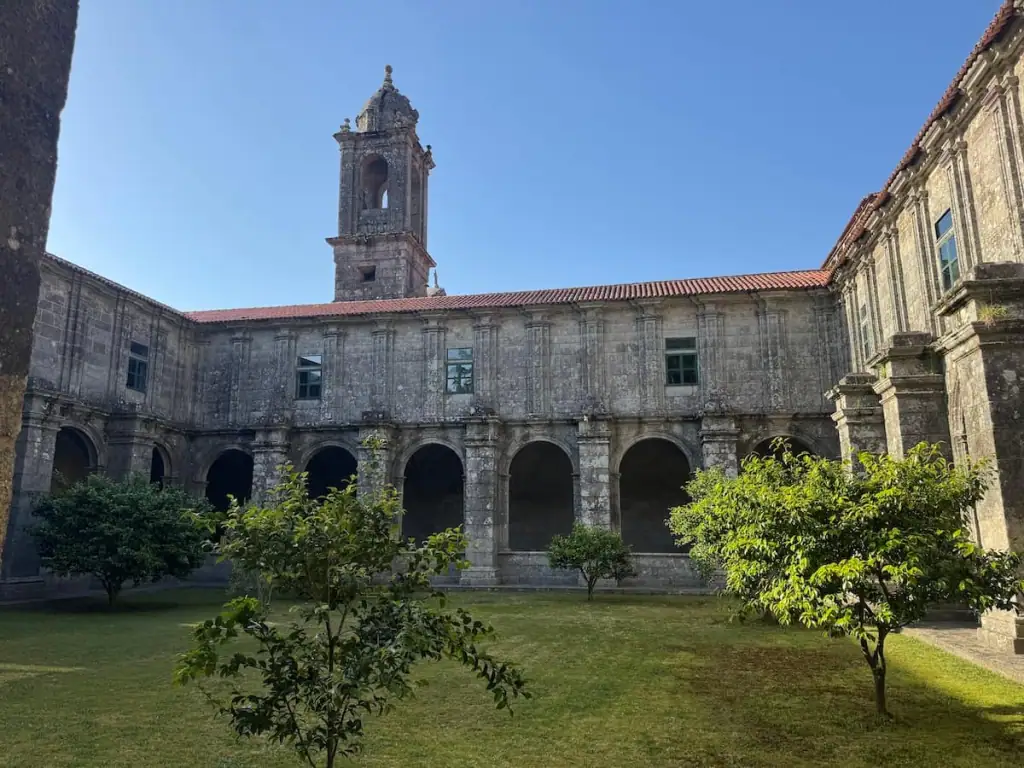
Guide to Armenteira
- Where to Stay: A Fragua Do Ferreiro (private albergue–shared and private rooms), Albergue de Peregrinos San Ero Armenteira (municipal albergue–shared rooms), Mosteiro de Santa María da Armenteira (monastery–private rooms)
- Where to Eat: Bar O Comercio for pilgrim meals, snacks, and drinks
- Things to Do: Visit the monastery for a pilgrim's blessing at 7 p.m.
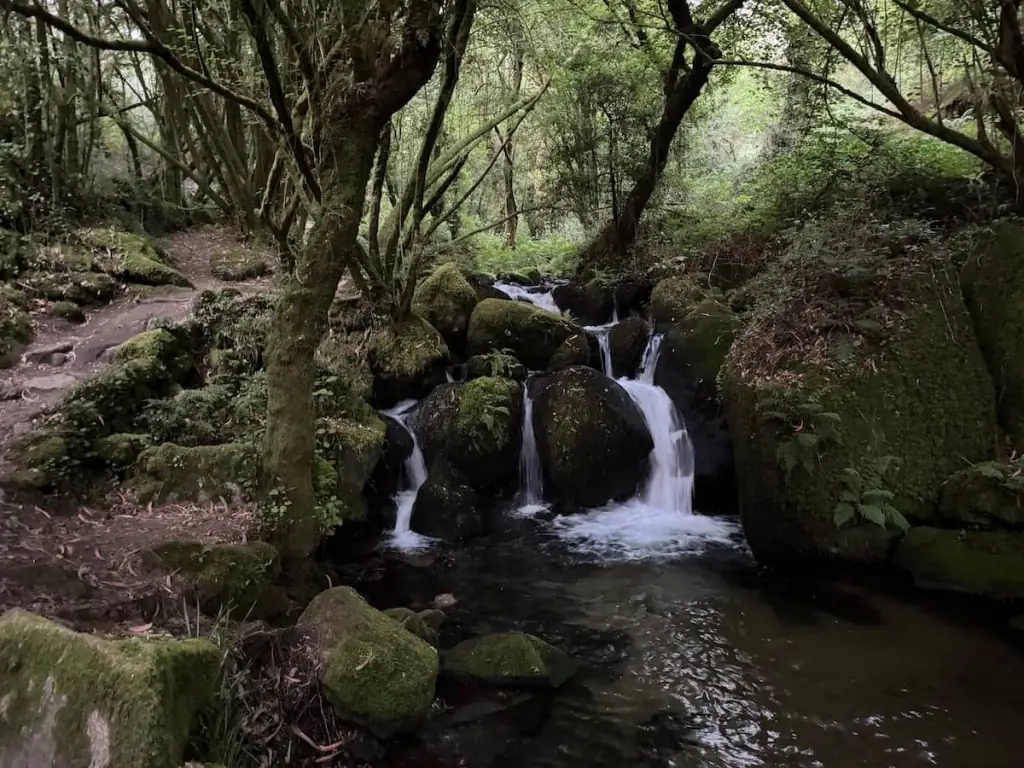
Stage 2: Armenteira to Vilanova de Arousa
Official Distance: 14.7 miles (23.7 km)
Elevation Gain: 765.4 ft (233.3 m)
Elevation Loss: 1,511.3 ft (460.6 m)
This walk was one of my favorites between both of my Portuguese Caminos. Leaving Armenteira, you take a route called Ruta de la Piedra y del Agua, which translates to route of rock and water. This lovely route follows a stream in the woods for quite some time.
You continue along the stream for much of the hike but eventually pop out to follow along more vineyards and fields with views of mountains in the distance.
The hardest part of this hike is the limited number of places to stop along the way. Definitely make a stop if you see a cafe and need some food or a bathroom break because you may not see anything else for a while.

Stops Along the Way
- Aldea Labrega (2.4 miles/3.9 km from previous stop)–Visit Gastrobar Ruta da Pedra e da Auga in a park for amazing homemade pastries.
- Os Castaños (1.7 miles/2.8 km from previous stop)–People rave about the Chiringo de Concha for food. Hotel Os Castaños is a nice place to stay here.
- Ponte Arnelas (3.9 miles/6.2 km from previous stop)–O Legado de Ramira is a nice hotel with a bar. From here you'll walk along some bigger roads until you turn off to Mouzos.
- Gombra (0.7 miles/1.1 km from previous stop)
- Mouzos (0.7 miles/1.1 km from previous stop)–The small chapel Capela de San Pedro de Mouzos in town is open briefly in the afternoon and welcoming to pilgrims. They have a stamp too.
- Cores (3.2 miles/5.1 km from previous stop)–Shortly after Cores, you reach the ocean. There are a number of beach bars and cafes along the way from here to Vilanova de Arousa.
After Cores, it's 2.2 miles/3.5 km to Vilanova de Arousa.

Guide to Vilanova de Arousa
- Where to Stay: A Corticela (private albergue–shared rooms), Albergue Variante Espiritual (municipal albergue–shared room), Hotel Bradomin (hotel–private rooms)
- Where to Eat: Bar Restaurante Faro Da Lúa for seafood or other dishes
- Things to Do: Relax on the beach at Posta da Secada
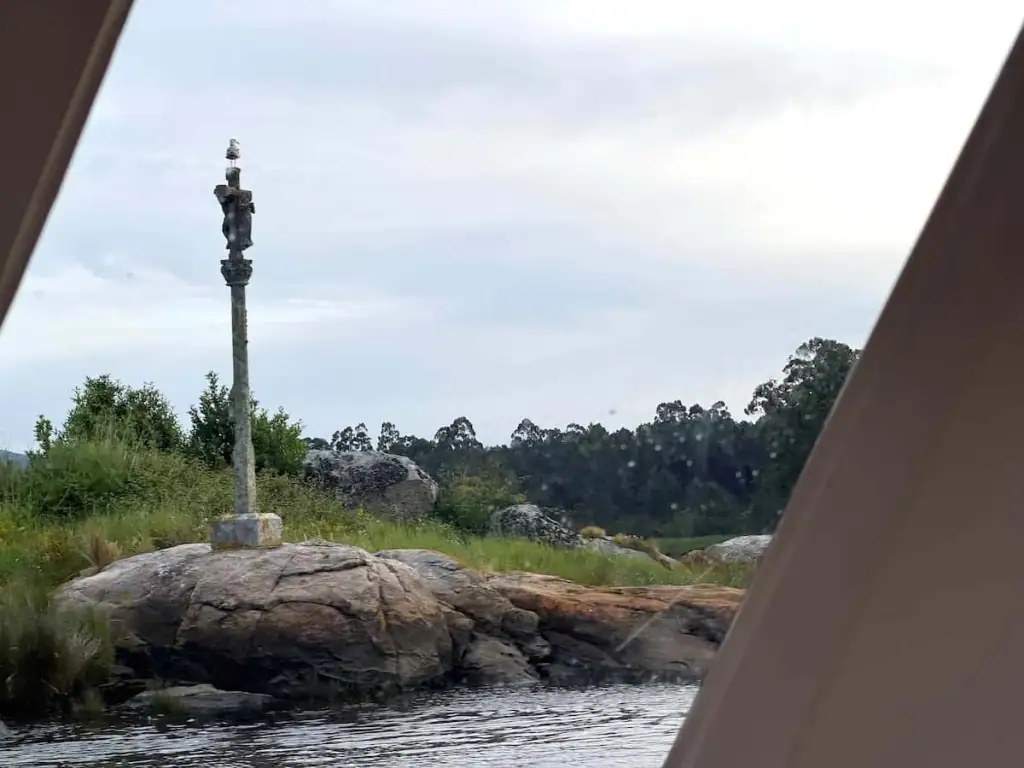
Stage 3: Vilanova de Arousa to O Milladoiro (Including Boat Ride)
Official Distance: 12.7 miles (20.5 km) + boat ride
Elevation Gain: 1,704.0 ft (519.4 m)
Elevation Loss: 743.2 ft (226.5 m)
Most pilgrims start this day by taking a boat from Vilanova de Arousa to Pontecesures. You need to book the boat in advance as there are limited seats and departure times available.
The boat ride takes about 1 hour and 20 minutes. You get to see all sorts of things on the way that the boat guide will explain:
- Mussel farms–a huge industry in Galicia
- West Towers in Catoira–castle ruins that were built long ago to protect Galicia from viking attacks
- 12 crosses–built in memory of Saint James
Note that it's possible to walk instead of taking the boat, but it's not recommended. The walk would be about 20.6 miles (33.1) km. It involves a lot of road walking and isn't very scenic from what I've heard.
After the boat ride, Padrón will be the only big city you walk through before you spend the rest of the way walking through small villages and forests.
Note: If you want to get to Santiago de Compostela in the same amount of time you would if you hadn't taken the Spiritual Variant, then you can combine stages 3 and 4. Many pilgrims do this, but be prepared for a long last day.
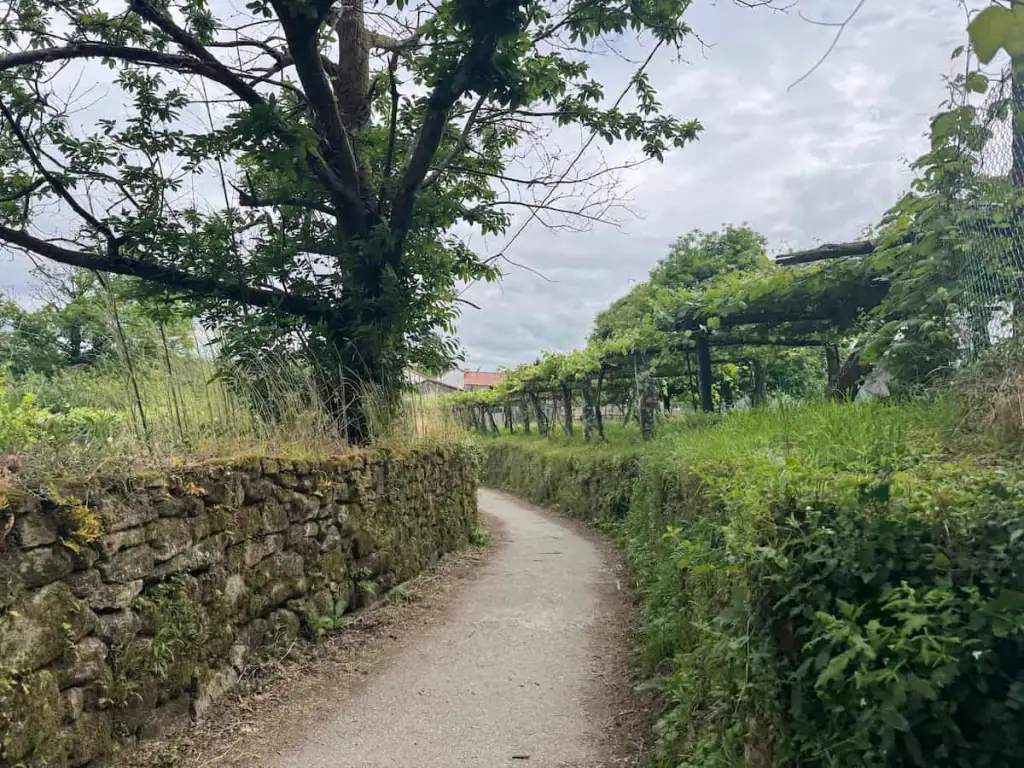
Stops Along the Way
- Pontecesures via Boat Ride (17.4 miles/28.0 km from previous stop)–The boat ride to Pontecesures takes approximately 1 hour and 20 minutes but may be slightly faster or slower depending on the tides.
- Herbón (1.7 miles/2.7 km from previous stop)–Many pilgrims don't take this detour to Herbón but those who do and spend the night at the albergue at the Monastery of Herbón say it's incredible and really worth it.
- Aduana (0.9 miles/1.4 km from Pontecesures)–A Ponte do Peregrino is a great cafe right after the bridge.
- Padrón (1.2 miles/1.9 km from Aduana, 1.9 miles/3.0 km from Herbón)–Here you can see the pillar where the boat that brought the remains of Saint James supposedly docked. It's located in the Iglesia de Santiago Apóstol de Padrón right off the Camino route in the city center.
- Iria Flavia (0.6 miles/0.9 km from previous stop)
- Pazos (1.2 miles/2.0 km from previous stop)–You can stop at Cafeteria Camiño Portugues for a quick bite or a drink. It's the last stop for a while, so I recommend popping in for something small and a bathroom break even if you're not hungry.
- Rueiro (0.4 miles/0.6 km from previous stop)
- Tarrio (0.6 miles/0.9 km from previous stop)
- Vilar (0.6 miles/0.9 km from previous stop)
- A Escravitude (0.5 miles/0.8 km from previous stop)–Villa Vieira is a fantastic new albergue here with a pool. I stayed there when I did the Central route and highly recommend it.
- Angueira de Suso (1.2 miles/1.9 km from previous stop)–Camiño da Vieira is a nice albergue here.
- Areal (0.4 miles/0.7 km from previous stop)
- Picaraña (0.2 miles/0.4 km from previous stop)
- O Faramello (0.8 miles/1.3 km from previous stop)–If you need to grab a quick bite, you can stop at Lar, Breakfast & Meals.
- Rúa de Francos (0.6 miles/0.9 km from previous stop)
- Osebe – Casalonga – Pedreira (0.9 miles/1.4 km from previous stop)
- A Grela (2.4 miles/3.9 km from previous stop)
From A Grela it's 0.4 miles/0.6 km to O Milladoiro.
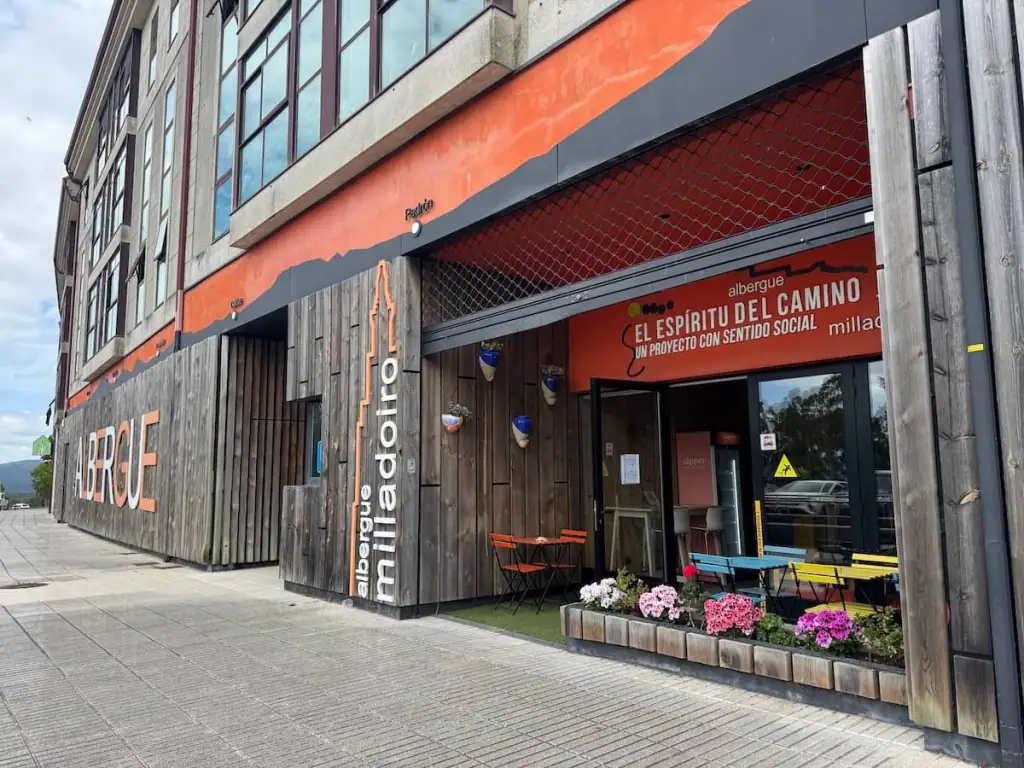
Guide to O Milladoiro
- Where to Stay: Albergue Milladoiro (private albergue–shared rooms), Pension O Camiño Milladoiro (pensión–private rooms), Hotel PAYRO (hotel–private rooms)
- Where to Eat: La Trastienda del 7 for dinner, O Camiño Milladoiro for breakfast or a snack

Stage 4: O Milladoiro to Santiago de Compostela
Official Distance: 4.2 miles (6.7 km)
Elevation Gain: 821.1 ft (250.3 m)
Elevation Loss: 613.8 ft (187.1 m)
Leaving O Milladoiro, you'll walk through some small villages, but it won't be long until you reach the outskirts of Santiago de Compostela. With that in mind, there are no stops along the way to note here.
Guide to Santiago de Compostela
- Where to Stay: Hostal Real de Santiago de Compostela Parador Hotel (hotel–private rooms, such a treat if you want to splurge!), Santiago KM-0 (private albergue–shared rooms), Hostal Alda Catedral (hotel–private rooms); read about these and other top places to stay in this article
- Where to Eat: Cáscara Café for lunch or brunch, Abastos 2.0 for Michelin-recognized but affordable dining, Taberna O Gato Negro for tapas and Galician cuisine
- Things to Do: Check out this article dedicated to recommended activities for pilgrims
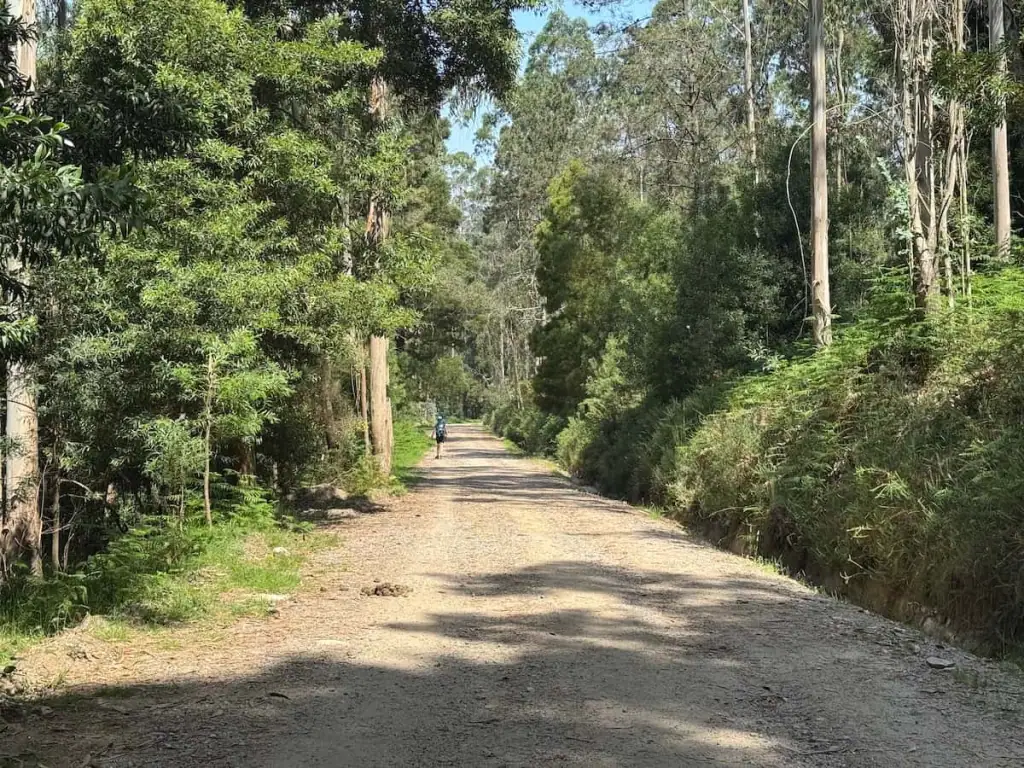
Is the Spiritual Variant Safe for Solo Women?
While a quieter route with fewer people around may sound nice, it always begs the question: is it safe for solo women?
I'll be honest, I was a little nervous myself about this. I had read a few reports in Facebook groups about women being followed by creepy men along this route. That said, I also saw reports of that happening along stretches of the Camino Portugués Coastal and Central routes too.
Thankfully I never had any issues along the way. There were a few times where it felt a little eerie with few people around, but I always bumped into someone after some time so knew I was never fully alone.
Typically the Camino is very safe and there are plenty of solo women hiking without issues, but it's a good idea to remain alert and trust your gut if anything ever feels off.
Connect with Other Women Hiking the Camino
Join my free Facebook group! We're building up a community of women who have hiked or are planning to hike the Camino there. You can also get personalized support from me!

Can You Still Get Your Compostela Certificate?
Pilgrims who want the Compostela certificate from the Pilgrim's Office in Santiago de Compostela have to walk at least 100 km. With that in mind, you might be wondering if taking the boat would forfeit your chance of getting a certificate.
The good news is that it doesn't and you can still get a certificate. This way is accepted by the Pilgrim's Office and plenty of pilgrims do it each year.
Please note, however, that the Pilgrim's Office does not count the extra distance walked on the Spiritual Variant. Keep this in mind as you think about where to start your Camino.
At a minimum, you still need to start in either Vigo or O Porriño to get the required 100 km. You can't start closer to Santiago de Compostela and think the extra distance on the Spiritual Variant will count.
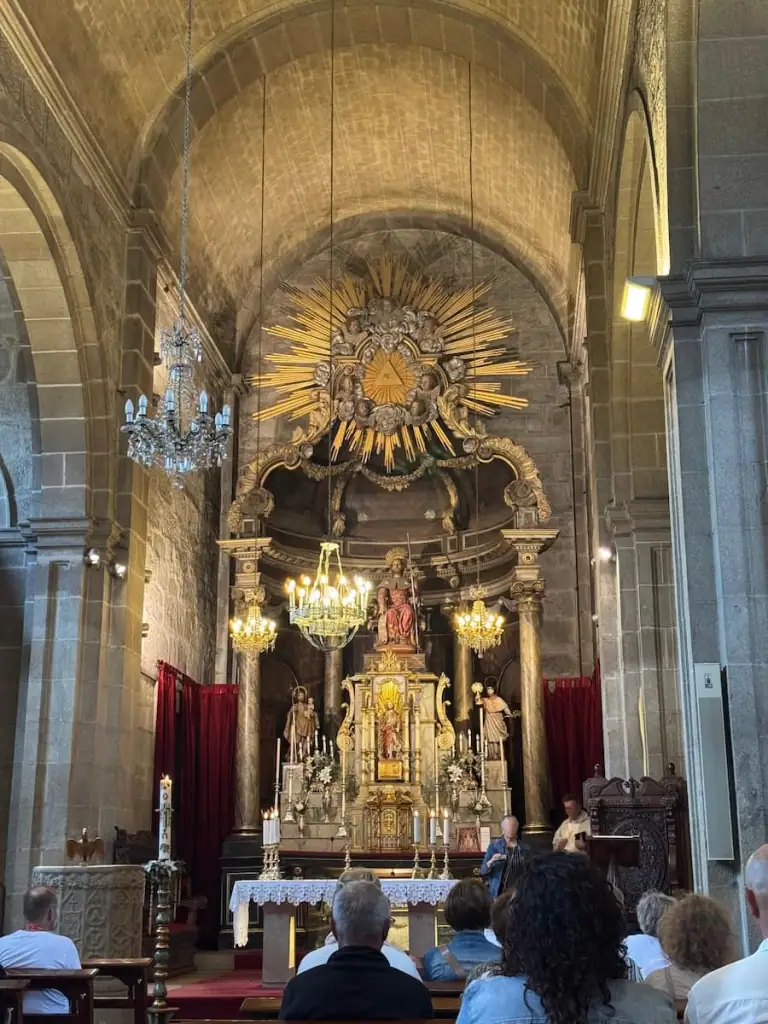
Certificate for the Spiritual Variant in Padrón
After I finished my last Camino, I heard a rumor that there's a special certificate you can get in Padrón to commemorate your time on the Spiritual Variant.
As I've looked further into it, that's not quite true, but Padrón does have its own certificate tied very closely to the events that inspired the Spiritual Variant. In 2010, the Padrón Town Council launched what they call the Pedronía certificate to recognize the arrival of Saint James's body there.
To get this certificate during your Camino, you need to get a stamp at the Iglesia de Santiago Apóstol de Padrón. This is the same church where you can see the granite pillar where the boat that brought the remains of Saint James supposedly docked.
Then visit the tourist office or municipal albergue and ask for the Pedronía, showing your pilgrim passport with your stamps. The certificate costs 2 euros.
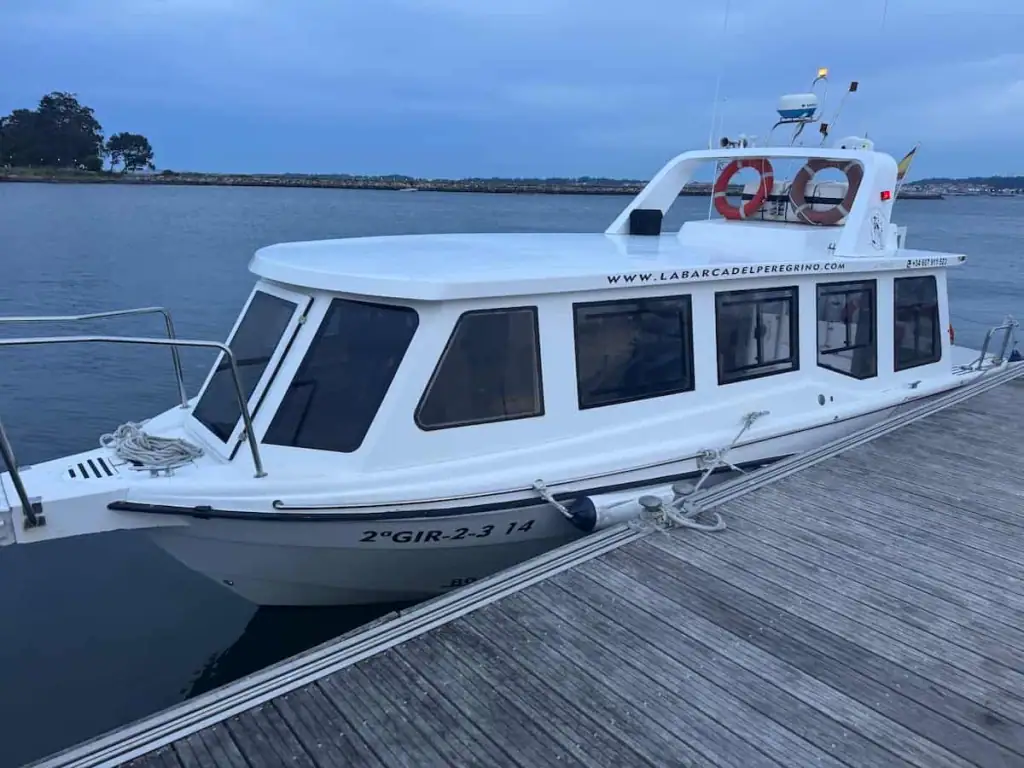
Spiritual Variant Camino Boat Logistics
The main company that operates this boat journey is called La Barca del Peregrino. The journey lasts about 1 hour and 20 minutes. Tickets cost 30 euros each.
It's a good idea to book the boat in advance because there aren't many departures each day. The boat is bigger than the boat typically used to cross the river in Caminha on the coastal route, but it can still fill up quickly.
Boats only leave in the morning, typically with two or three departures per day between 7 a.m. and 11:30 a.m. Schedules vary each day so check the website to be sure.
Note that it's very important to arrive early, at least 10 minutes early or sooner. This is not one of those activities that runs on Spanish time. They keep a close eye on the tides and sometimes leave a little bit earlier.
I also recommend messaging them on WhatsApp the day before to double check that the departure time is the same. Sometimes they will move it up due to the tides and you don't want to miss it. You can message them on WhatsApp here: +34 607 91 15 23
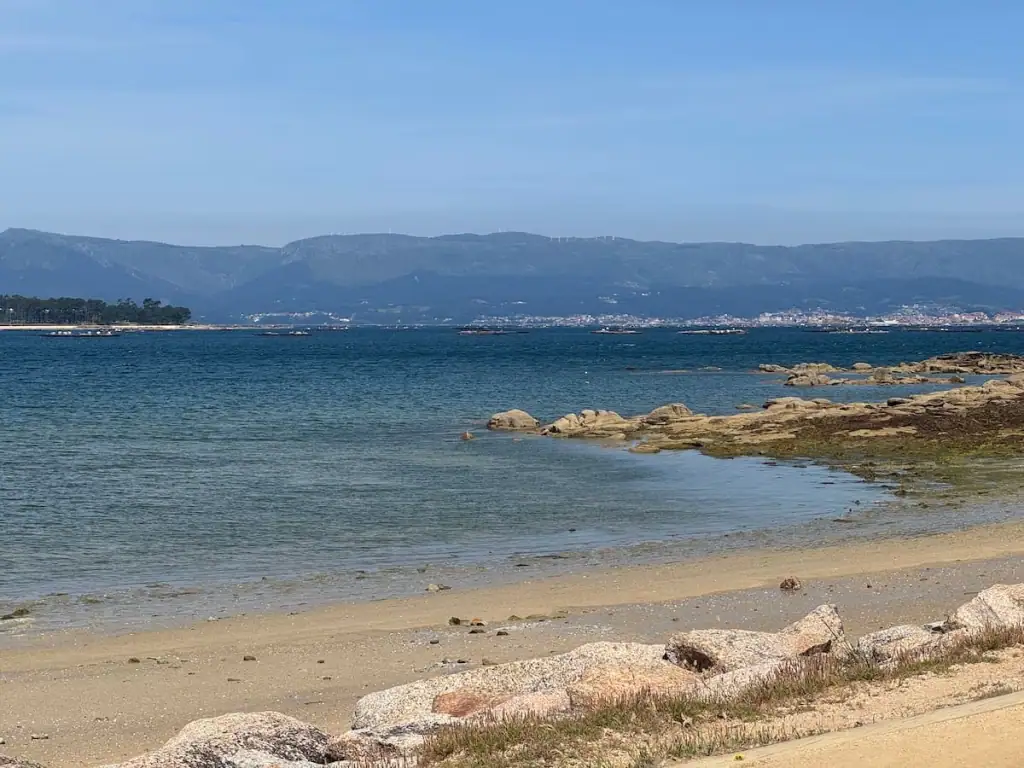
Conclusion: Is the Camino Spiritual Variant Right for You?
As you can see, the Camino Spiritual Variant can be a really special and unique way to finish your Camino. It offers a variety of scenery, is a good way to avoid crowds, and allows you to follow the way of the journey that started it all.
Camino Spiritual Variant Stages PDF
As you keep planning your walk along the Portuguese Way, go ahead and download this itinerary so you have a condensed version to print out. This also includes stages for the Central and Coastal routes to help you piece together your whole Camino.
Plan the Rest of Your Camino Portugués
As you plan the rest of your Camino Portugués, check out these articles on the Coastal route stages and Central route stages. You can also read about some of the best places to stay on the Portuguese Way.
